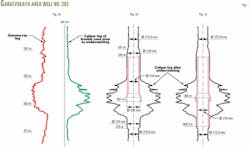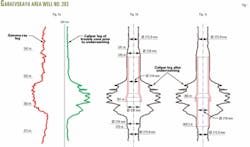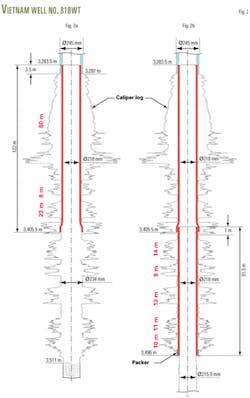Expandable-profile liners have stabilized problem wellbores throughout Russia, solving lost circulation and wellbore stability problems, regardless of severity or the size of wellbore washouts.
Oil companies have installed more than 1,000 of these expandable-profile liners as an alternative to running intermediate casing strings.
Tatar Oil Research & Design Institute (TatNIPIneft) has advanced this technology to extend casing strings with profile liners, without loss of wellbore diameter, to solve lost-circulation control issues that are complicated by drag and sticking of the drillstring bottom-hole assembly (BHA).
Attempts to run casing strings to the required depth sometimes fail during well construction because of filter cake buildup or sludging, rock sloughing, and wellbore stability issues.
Such problems often result in numerous isolation jobs and on occasion require shutoff of problem intervals with intermediate casing strings and liners with resulting loss of wellbore diameter, more complicated wellbore designs, increased consumption of tubulars and cement, added capital investment, and time.
Unknown or incorrect depth information of incompatible formations can cause errors in casing string set point or length and create similar problems. Separate casing strings must isolate formations, which are incompatible under drilling conditions, even if the zones are thin or a short distance apart.
This unconventional technology, developed by TatNIPIneft, employs steel casing made from a proprietary alloy that when profiled throughout the liner length will run freely through its own fully expanded internal diameter.
Expandable underreamers enlarge the wellbore, through the problem-zone interval, to the external diameter of the initial nonprofiled casing string. Crews then run the profiled liner into place, across the problem formation interval, with a designed for purpose bottom-hole assembly and drill pipe.
Once the profiled liner is in place, pressure from drilling mud injection along with a specially designed expansion tool straightens and inflates the liner to the full working diameter of the wellbore, pressing it tightly against the underreamed formation face.
The profile liner uses packer elements to establish a seal with the casing above and at the end sections.
The operating company extended the casing string length in East Siberia Verkhne-Katangskaya area well No. 160 for the 219-mm (83/5-in.) casing to solve a difficult lost-circulation problem, saving the wellbore that had been considered for abandonment (OGJ, Sept. 11, 1995, p. 50).
Washed-out zone isolation
Hole-stability problems such as formation sloughing sometimes occur with lost-circulation zones and can cause drag and sticking of the drillstring and BHA.
The operating company Samaraneftegas had pioneered application of the expandable-profile-liner technology to case off a difficult lost-circulation zone, with accompanied BHA sticking problems, in Garaevskaya area well No. 202.
The rig was drilling the well's 215.9-mm (81/2-in.) hole section when difficult lost-circulation problems occurred at 353-366.5 m. Sloughing of the wellbore accompanied the lost circulation, causing the drillstring and BHA to drag and get stuck.
Drilling the well deeper was impossible. Operations to regain circulation conventionally with lost-circulation material continued for 34 days but failed, and the operator decided to use profile liners to attempt shutting off the problem zones.
Fig. 1 shows the caliper log over the problem interval, before and after underreaming in preparation for the expandable liner, and the sequence of operations.
The rig ran an expandable underreamer, referred to as RRM 216/234, and reamed the interval 341-370 m, opening the hole to 234 mm.
Crews then ran the 16-m long section of profile liner and set it in the interval 345-361 m, then applied pressure through the drillstring to straighten the liner to its final cylindrical shape (Fig. 1b).
The operation had pressed the profile liner walls tightly against the wall of the reamed section of the wellbore above the cavern or washout, which crews checked by pulling on the drillstring.
Rotating the drill pipe to the right disconnected the liner-setting tools from the liner that had been set and the rig tripped the drillstring out of the well.
Crews used expanders, which the companies name RSh-196, RSh-208, and RSh-218, to expand the liner fully to its final 218-mm ID. The rig used a three cone, 215.9-mm drillbit to clean out a cement plug and continue drilling to the bottomhole.
To isolate the washout or cavern completely, the rig ran a lower section 8.5-m long (one joint of pipe) profile liner using the same technology. Crews set the liner in the interval 360-368.5 m, overlapping the lower end of the first liner by a length of 1 m (Fig. 1c).
The profile-liner setting operations took only 60 hr and successfully isolated the problem zone.
This job was the first interval isolation of a sloughing, lost-circulation zone using two profile liners connected tightly between each other in the well without cementing and without loss of working wellbore diameter.
Upon isolation of the problem zone, the operating company drilled the well to its final total depth of 2,670 m, without further problems. The rig completed drilling operations in 836.7 hr and 19 bit trips.
Long-interval isolation
Building on the experience of extending casing strings by adding profile liners at the bottom, engineers applied the technology to Viet Nam's White Tiger oil field well No. 818WT, which had extremely difficult lost-circulation and wellbore stability issues.
Lost-circulation zones in the Lower Miocene, which included intense sloughing intervals, had complicated drilling operations. The operating company had suspended and shut-in the well for 3 years because of the continuous problem of the drillstring getting stuck.
Through arrangement between OAO Tatneft and Petrovietnam's joint venture VietSovPetro, the companies agreed to run a 210-m profile liner that would case off all of the lost-circulation Lower Miocene zones and resolve the drillstring sticking issues.
In the process of conditioning the borehole prior to running the profile liner in the interval 3,287-3,496 m, however, crews faced the following operational problems:
- Continuous drag and jamming of the drilling tools occurred, when conditioning the wellbore or circulating mud in the interval 3,287-3,564 m. Violent sloughing and hole caving required the rig to pull the stuck drillstring using jars.
- Crews could only run the drillstring and BHA freely to 3,350 m and further running was possible only with flushing and conditioning of the borehole. For the rig to pull the drillstring through the interval 3,550-3,369 m, crews had to circulate for every other joint pulled from the wellbore.
In light of these problems, engineers decided to isolate the entire interval by setting profile liners in two stages:
- The first stage profile liner isolated the most severe lost-circulation and washed out intervals from 3,287 m to 3,405.5 m (118.5 m). The liner isolated three severe washouts or caverns that were 80 m, 8 m, and 21 m thick, individually (109 m total).
- The second stage profile liner isolated five smaller washouts from 3,405.5 m to 3,496 m, which individually were 14 m, 8 m, 13 m, 11 m, and 10 m, thick (56 m total).
Figs. 2a and 2b show the well's caliper log and details of the two profile liners.
For the first profile liner, operations began by milling the inside wall of the lower end of the 95/8-in. casing from 223 mm to 234 mm, in the interval 3,282-3,287 m.
Crews then used expandable reamers, called RRM 216/234, to ream the openhole interval 3,287-3,415 m, performing the job in two trips to replace worn cutters. Intense sloughing required simultaneous mud circulation and hole conditioning during the reaming operations.
After the rig had conditioned the wellbore to 3,415 m, with a BHA that included a one-blade spiral gauger, crews assembled and ran the profile liner to 3,405.5 m leaving a 3.5-m overlap with the 95/8-in. casing.
A cementing unit applied pressure to the drillstring, up to 10 MPa (1,450 psi), straightening out the profile liner. Turning the drillstring to the right released left-hand threads on the profile liner's upper packer, leaving the liner in place.
The liner expander tool called an RSh-196, which was run on the drillstring, successfully expanded the liner. Subsequent runs with the one-roller (RSh-216) expander and the three-roller (RR-170/218) expander further extended the liner's diameter.
The rig reamed and conditioned the openhole interval 3,405.5-3,511 m, before running and setting of the second profile liner.
A reamer (RRM 216/234), with toothless cutters, reamed and prepared the bottom end of the first liner. Using the expander, the rig prepared the bottom 1 m of the liner from 3,404.5 m to 3,405.5 m, opening the section to 232 mm ID.
Crews encountered no problems while running in with the 91.5 m long, second profile liner. The liner set successfully with 10 MPa expansion pressure. The rig checked the liner's stability, detached the running tool, and pulled the drillstring out of the hole.
The rig expanded the second profile liner in the interval 3,405.5-3,496 m using single-roller, RSh-196 and RSh-216, expansion tools and the three-roller, RR 170/218, expanders.
The top 1 m of the second liner achieved a tight connection and seal with the bottom 1 m of the first liner.
Casing off the Lower Miocene formations with the two profile liners, tightly joined with each other and to the 245-mm casing string allowed drilling operations to raise the mud weight or density to 1.64 tonnes/cu m (13.7 ppg). This created a pressure differential on the profile liners of 19 MPa.
The operator continued drilling the 215.9 mm hole section of the well to 4,010 m, entering the Upper Oligocene. The rig ran and cemented the 194-mm liner in the interval 3,210-4,010 m with no problems.
Operating companies have successfully used expandable-profile liner technology, or local well casing, to shutoff lost-circulation zones, control drilling-tool sticking problems, as well as for interval isolation of washed out or cavernous zones.
The technology has solved intense formation-sloughing problems by extending the bottom of casing strings that could not have been run to the required depth without cementing and without loss of working-hole diameter.
The technology has also gained international recognition, with companies in China, Egypt, Iran, Italy, and Vietnam signing contracts for its application.
Acknowledgments
The authors would like to thank Izil G. Yusupov, Rustam K. Ibatullin, Albert G. Zainullin, V.P. Fillipov for their contributions to this work.
The authors
Shafagat F. Takhautdinov is the director general of the joint stock company OAO Tatneft. He graduated, in 1971, as a mining engineer from the Moscow Petrochemical and Gas Institute, from which he also holds a PhD in technical science. His professional interests include various aspects of oilfield operations, oil production, gathering, transportation, and environmental protection.
Gabdrashit S. Abdrakhmanov is a chief drilling expert in the External Economic Co. of the joint stock company OAO Tatneft. He graduated from the Moscow Petrochemical and Gas Institute and holds a Dr. degree in technical science. He is a professor and corresponding member of the Russian Academy of natural sciences. He has more than 20 years of experience in local casing of wells.
Nigmatyan K. Khamityanov is a head of well construction and workover department in Tatar Oil Research and Design Institute (TatNIPIneft). He graduated from the Ufa Petroleum Institute and has 10 years of experience in local well casing using profile liners.
Nail N. Vildanov is a senior research worker in the well construction and workover department in Tatar Oil Research and Design Institute (TatNIPIneft). His responsibilities include design and introduction of technological processes for local well casing using profile liners. Holds an MS in oil and gas well drilling. He previously worked in the Aznakaevo drilling department, in charge of drilling oil wells.
Khamit Z. Kaveev is a deputy director general of the joint stock company OAO Tatneft, director of the External Economic Co. and has been in charge of external economic activity of Tatneft since 1999. Holds a PhD in economics from the Kazan Aircraft Institute. Previously worked in the Tatoilpetro joint venture where held the position of deputy director on economics and in the Tatex joint venture as a general director.




